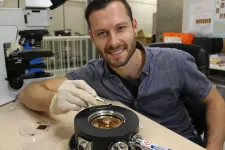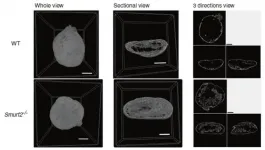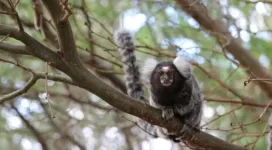(Press-News.org) DALLAS - Feb. 8, 2021 - Pregnant women, who are at increased risk of preterm birth or pregnancy loss if they develop a severe case of COVID-19, need the best possible guidance on whether they should receive a COVID-19 vaccine, according to an article by two UT Southwestern obstetricians published today in JAMA. That guidance can take lessons from what is already known about other vaccines given during pregnancy.
In the Viewpoint article, Emily H. Adhikari, M.D., and Catherine Y. Spong, M.D., describe how the available safety and effectiveness data, basic science of mRNA vaccines, and long history of successful administering of other vaccines in pregnant women worldwide sets the backdrop for obstetricians to outline the potential benefits of COVID-19 prevention with their patients.
Vaccines against diseases such as influenza and whooping cough have shown to be lifesaving for women and newborns when administered to pregnant women. The pertussis vaccine reduced whooping cough, a potentially fatal respiratory illness in infants, by 85 percent compared with waiting until after pregnancy. Influenza vaccination during pregnancy reduced both mother and infant influenza illness by 20 and 30 percent, respectively. Although it is not known what level of infant protection might be provided against COVID-19 by maternal vaccination, Adhikari says the potential for protection exists.
In the article, Adhikari and Spong describe how pregnant and lactating women were excluded from clinical trials during the development of COVID-19 vaccines due to concerns over liability. As a result, guidance issued by professional organizations on the topic has been limited, leaving physicians responsible for discussing the pros and cons with patients based on benefits of other vaccines used during pregnancy, evidence from COVID-19 vaccine trials in nonpregnant patients, and basic vaccine science suggesting safety for the fetus.
"We still need granular data on safety in pregnancy and data that shows no adverse pregnancy outcomes," says Adhikari, an assistant professor of obstetrics and gynecology at UT Southwestern.
"But without that data, we still have to care for our patients. It's not something where we can just wait," says Spong, a UTSW professor of obstetrics and gynecology, who will speak about the issue in a virtual JAMA panel discussion today at 2 p.m. EST. astern Standard Time.
Both the American College of Obstetricians and Gynecologists and the Society for Maternal-Fetal Medicine have advocated for making COVID-19 vaccines available to pregnant and lactating women. The World Health Organization on Jan. 26 recommended against vaccinating pregnant women using the Moderna vaccine except in select circumstances, but three days later revised its statement to more permissive language, supporting offering the vaccine to pregnant women at high risk of exposure or with comorbidities in consultation with their health care provider. However, the change in language caused significant anxiety despite no concerning data that was made available.
"I am very supportive of any woman who decides to get the vaccine," Adhikari says. "I fully support that woman's choice. I understand if a woman decides she's not ready for the vaccine, but I also think it's an opportunity for education about vaccines in general."
Adhikari previously published a study of 3,374 pregnant women, including 252 who had contracted COVID-19 during pregnancy and 3,122 who tested negative. They found no increase in adverse pregnancy outcomes overall. But among the 5 percent of pregnant women who were hospitalized for COVID-19 respiratory illness, preterm births increased.
The Viewpoint article reviews how the major risks to a pregnancy are from maternal respiratory illness from COVID-19, and states that prevention is key.
"Women who are pregnant, who have severe respiratory distress, who need significant oxygen support - some intubated for months - have most risk to the pregnancy," says Spong, who holds the Gillette Professorship of Obstetrics and Gynecology.
For a wider context, the piece reviews how the messenger RNA vaccines proved safe and effective in preventing COVID-19, and that the same technology has been tested in trials for prevention or treatment of other diseases.
"We are doing ongoing data collection to demonstrate what we anticipate but have not shown - that this vaccine is safe in pregnant women, does not result in harm, and results in no difference in pregnancy outcomes," Adhikari says. "It's important for us to study that. That's going to help establish an evidence basis that will allow the public and clinicians to feel more comfortable with the vaccine."
INFORMATION:
About UT Southwestern Medical Center
UT Southwestern, one of the premier academic medical centers in the nation, integrates pioneering biomedical research with exceptional clinical care and education. The institution's faculty has received six Nobel Prizes, and includes 23 members of the National Academy of Sciences, 17 members of the National Academy of Medicine, and 13 Howard Hughes Medical Institute Investigators. The full-time faculty of more than 2,500 is responsible for groundbreaking medical advances and is committed to translating science-driven research quickly to new clinical treatments. UT Southwestern physicians provide care in about 80 specialties to more than 105,000 hospitalized patients, nearly 370,000 emergency room cases, and oversee approximately 3 million outpatient visits a year.
DALLAS - Feb. 8, 2021 - A new nanoparticle-based drug can boost the body's innate immune system and make it more effective at fighting off tumors, researchers at UT Southwestern have shown. Their study, published in Nature Biomedical Engineering, is the first to successfully target the immune molecule STING with nanoparticles about one millionth the size of a soccer ball that can switch on/off immune activity in response to their physiological environment.
"Activating STING by these nanoparticles is like exerting perpetual pressure on the accelerator to ramp up the natural innate immune response to a tumor," says study leader Jinming Gao, Ph.D., a professor in UT Southwestern's Harold C. Simmons Comprehensive ...
AURORA, Colo. (February 8, 2021) - Researchers from the Barbara Davis Center for Childhood Diabetes at the University of Colorado Anschutz Medical Campus have found that immune responses to insulin could help identify individuals most at risk for developing Type 1 diabetes.
The study, out recently in the Proceedings of the National Academy of Sciences, measured immune responses from individuals genetically predisposed to developing Type 1 diabetes (T1D) to naturally occurring insulin and hybrid insulin peptides. Since not all genetically predisposed individuals ...
An international team of scientists has invented the equivalent of body armour for extremely fragile quantum systems, which will make them robust enough to be used as the basis for a new generation of low-energy electronics.
The scientists applied the armour by gently squashing droplets of liquid metal gallium onto the materials, coating them with gallium oxide.
Protection is crucial for thin materials such as graphene, which are only a single atom thick - essentially two-dimensional (2D) - and so are easily damaged by conventional layering technology, said Matthias Wurdack, who is the lead author of the group's publication in Advanced Materials.
"The protective coating ...
A framework designed to provide detailed information on agricultural groundwater use in arid regions has been developed by KAUST researchers in collaboration with the Saudi Ministry of Environment Water and Agriculture (MEWA).
"Groundwater is a precious resource, but we don't pay for it to grow our food, we just pump it out," says Oliver López, who worked on the project with KAUST's Matthew McCabe and co-workers. "When something is free, we are less likely to keep track of it, but it is critical that we measure groundwater extraction because it impacts both food and water security, not just regionally, but globally."
Saudi Arabia's farmland is often irrigated via center pivots that tap underground aquifer sources. The team has built a powerful tool ...
Osaka, Japan - Bone morphogenetic protein (BMP) has a strong osteogenic (bone forming) ability. BMP has already been clinically applied to spinal fusion and non-union fractures. However, dose-dependent side effects related to BMP use, such as inflammatory reactions at the administration site, prevent widespread use.
For safe use, it was necessary to clarify how the BMP signaling pathway is controlled. In a report published in Bone Research, a group of researchers from Osaka University and Ehime University has recently identified a novel role for the protein Smurf2 in regulating bone formation by BMP.
When BMP transmits its message within cells, it can induce rapid bone formation. Previous studies have shown that Smurf2 can control another similar ...
Lithium metal batteries could double the amount of energy held by lithium-ion batteries, if only their anodes didn't break down into small pieces when they were used.
Now, researchers led by Prof. CUI Guanglei from the Qingdao Institute of Bioenergy and Bioprocess Technology (QIBEBT) of the Chinese Academy of Sciences (CAS) have identified what causes lithium metal batteries (LMBs) to "self-destruct" and proposed a way to prevent it. The findings were published in Angewandte Chemie on Jan. 19.
This offers hope of radically enhancing the energy held in batteries without any increase in their size, and at reduced cost.
In fact, LMBs were the original concept for long-lasting ...
Tiny nanoparticles can be furnished with dyes and could be used for new imaging techniques, as chemists and physicists at Martin Luther University Halle-Wittenberg (MLU) show in a recent study. The researchers have also been the first to fully determine the particles' internal structure. Their results were published in the renowned journal Angewandte Chemie.
Single-chain nanoparticles (SCNPs) are an attractive material for chemical and biomedical applications. They are created from just a single chain of molecules that folds into a particle whose circumference measures three to five nanometres. "Because they are so small, they can travel everywhere in the human body and be used for a wide variety of purposes," says Professor Wolfgang ...
In humans, differences in personalities have been evident since the ancient times. Personality in animals has long been ignored, but recently this question has received increasing research interest as it has been realized that personality has evolutionary and ecological significance. An international team of behavioral biologists from Austria, Brazil and the Netherlands, with Vedrana Å lipogor from the University of Vienna as leading author of the study, designed a set of tasks to assess personality of common marmosets. These results have just been published in American Journal of Primatology.
Marmosets are small highly social New World monkeys that parallel humans in their social organization, as they live in cohesive ...
Researchers from the Institute of Environmental Science and Technology of the Universitat Autònoma de Barcelona (ICTA-UAB) warn of the impact the current tourism model in the Mediterranean islands has on the production of marine litter on beaches, and recommend taking advantage of the situation generated by the Covid19 pandemic to rethink a new more sustainable model. The research, recently published in the journal Scientific Reports, shows that the recreational use of Mediterranean island beaches during the summer is responsible for up to 80% of the marine litter accumulating on those beaches, and generates huge amounts of microplastics through the fragmentation ...
A German-Chinese research team has found a new synthetic route to produce biofuel from biomass. The chemists converted the substance 5-hydroxymethylfurfural (HMF) produced from biomass into 2,5-dimethylfuran (DMF), which could be suitable as a biofuel. Compared to previous methods, they achieved a higher yield and selectivity under milder reaction conditions. The team led by Dr. Baoxiang Peng and Professor Martin Muhler from the Laboratory of Industrial Chemistry at Ruhr-Universität Bochum (RUB) and the group led by Professor Christof Hättig from the RUB Chair for Theoretical Chemistry described the method together with colleagues from Changzhou, ...






